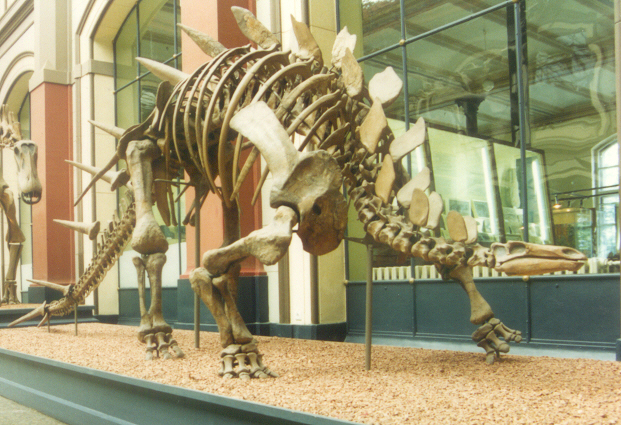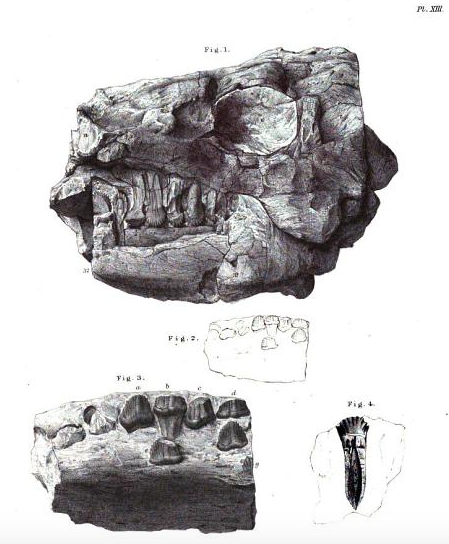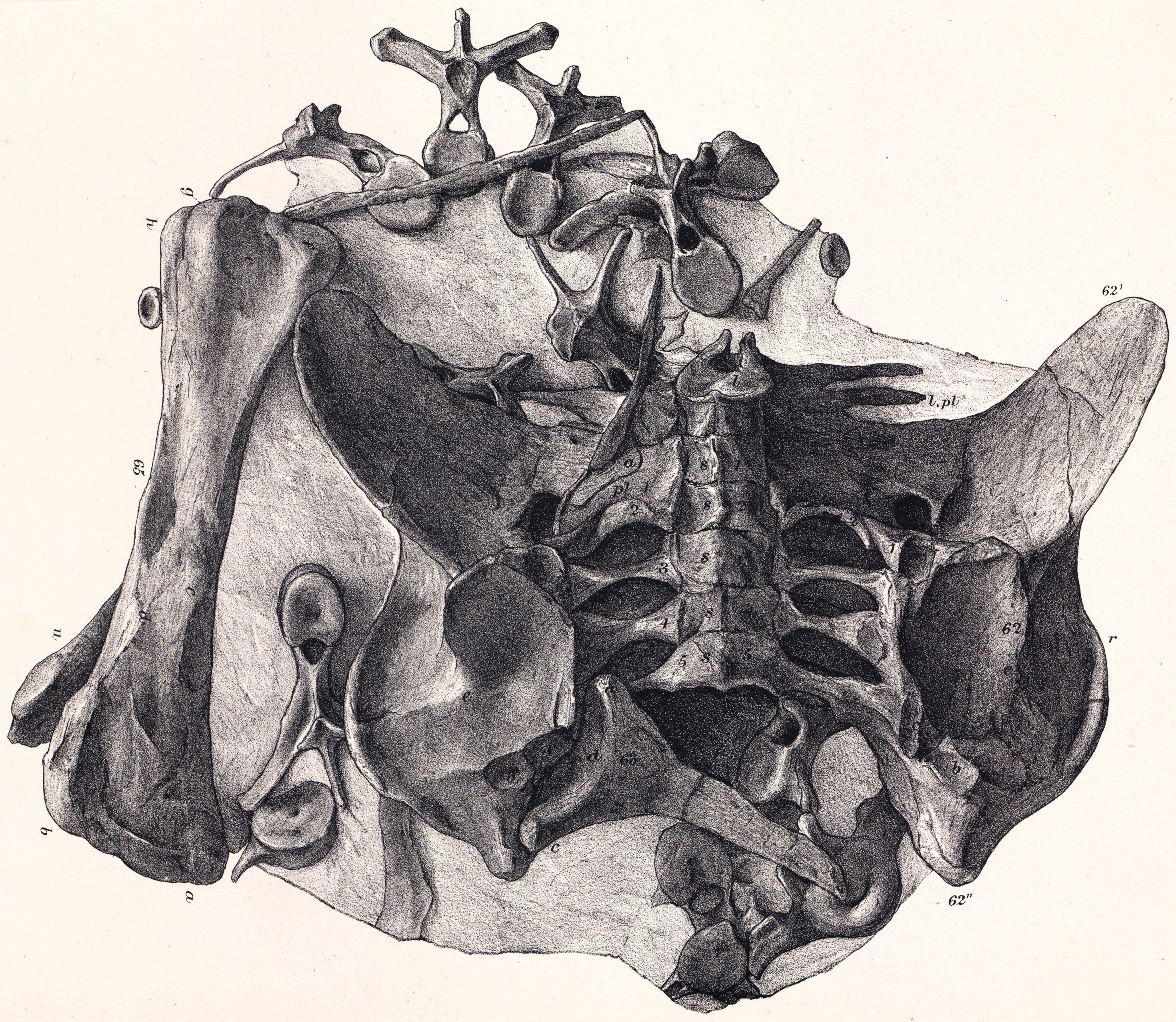|
Stegosauridae
Stegosauridae is a family of thyreophoran dinosaurs (armoured dinosaurs) within the suborder Stegosauria. The clade is defined as all species of dinosaurs more closely related to ''Stegosaurus'' than '' Huayangosaurus''.David B. Weishampel, Peter Dodson, Halszka Osmólska. The ''Dinosauria'' (2nd ed.). Berkeley: University of California Press. The name ‘Stegosauridae’ is thus a stem-based name taken from the well-represented genus – ''Stegosaurus'' (meaning ‘roofed lizard’). Fossil evidence of stegosaurids, dating from the Middle Jurassic through the Early Cretaceous, have been recovered from North America, Eurasia and Africa. The clade Stegosauridae is composed of the genera ''Stegosaurus'', ''Dacentrurus'', '' Miragaia'', '' Loricatosaurus'', and ''Kentrosaurus'', with the last considered to be at the base of the clade. The stegosaurids like all other stegosaurians were quadrupedal herbivores that exhibited the characteristic stegosaurian dorsal dermal plates. Thes ... [...More Info...] [...Related Items...] OR: [Wikipedia] [Google] [Baidu] |
Kentrosaurus
''Kentrosaurus'' ( ; ) is a genus of stegosaurid dinosaur from the Late Jurassic in Lindi Region of Tanzania. The type species is ''K. aethiopicus'', named and described by German palaeontologist Edwin Hennig in 1915. Often thought to be a " primitive" member of the Stegosauria, several recent cladistic analyses find it as more derived than many other stegosaurs, and a close relative of ''Stegosaurus'' from the North American Morrison Formation within the Stegosauridae. Fossils of ''K. aethiopicus'' have been found only in the Tendaguru Formation, dated to the late Kimmeridgian and early Tithonian ages, about 152 million years ago. Hundreds of bones were unearthed by German expeditions to German East Africa between 1909 and 1912. Although no complete skeletons are known, the remains provided a nearly complete picture of the build of the animal. In the Tendaguru Formation, it coexisted with a variety of dinosaurs such as the carnivorous theropods ''Elaphrosaurus'' and ''Veterupri ... [...More Info...] [...Related Items...] OR: [Wikipedia] [Google] [Baidu] |
Stegosauria
Stegosauria is a group of herbivorous ornithischian dinosaurs that lived during the Jurassic and early Cretaceous periods. Stegosaurian fossils have been found mostly in the Northern Hemisphere, predominantly in what is now North America, Europe, Africa, South America and Asia. Their geographical origins are unclear; the earliest unequivocal stegosaurian, '' Huayangosaurus taibaii'', lived in China. Stegosaurians were armored dinosaurs ( thyreophorans). Originally, they did not differ much from more primitive members of that group, being small, low-slung, running animals protected by armored scutes. An early evolutionary innovation was the development of spikes as defensive weapons. Later species, belonging to a subgroup called the Stegosauridae, became larger, and developed long hindlimbs that no longer allowed them to run. This increased the importance of active defence by the thagomizer, which could ward off even large predators because the tail was in a higher position, p ... [...More Info...] [...Related Items...] OR: [Wikipedia] [Google] [Baidu] |
Paranthodon
''Paranthodon'' ( ) is a genus of stegosaurian dinosaur that lived in what is now South Africa during the Early Cretaceous, between 139 and 131 million years ago. Discovered in 1845, it was one of the first stegosaurians found. Its only remains, a partial skull, isolated teeth, and fragments of vertebrae, were found in the Kirkwood Formation. British paleontologist Richard Owen initially identified the fragments as those of the pareiasaur '' Anthodon''. After remaining untouched for years in the British Museum of Natural History, the partial skull was identified by South African paleontologist Robert Broom as belonging to a different genus; he named the specimen ''Palaeoscincus africanus''. Several years later, Hungarian paleontologist Franz Nopcsa, unaware of Broom's new name, similarly concluded that it represented a new taxon, and named it ''Paranthodon owenii''. Since Nopcsa's species name was assigned after Broom's, and Broom did not assign a new genus, both names are no ... [...More Info...] [...Related Items...] OR: [Wikipedia] [Google] [Baidu] |
Stegosaurus
''Stegosaurus'' (; ) is a genus of herbivorous, four-legged, armored dinosaur from the Late Jurassic, characterized by the distinctive kite-shaped upright plates along their backs and spikes on their tails. Fossils of the genus have been found in the western United States and in Portugal, where they are found in Kimmeridgian- to early Tithonian-aged strata, dating to between 155 and 145 million years ago. Of the species that have been classified in the upper Morrison Formation of the western US, only three are universally recognized: ''S. stenops'', ''S. ungulatus'' and ''S. sulcatus''. The remains of over 80 individual animals of this genus have been found. ''Stegosaurus'' would have lived alongside dinosaurs such as ''Apatosaurus'', ''Diplodocus'', ''Brachiosaurus'', '' Ceratosaurus'', and ''Allosaurus''; the latter two may have preyed on it. They were large, heavily built, herbivorous quadrupeds with rounded backs, short fore limbs, long hind limbs, and tails held h ... [...More Info...] [...Related Items...] OR: [Wikipedia] [Google] [Baidu] |
Dacentrurus
''Dacentrurus'' (meaning "tail full of points"), originally known as ''Omosaurus'', is a genus of stegosaurian dinosaur from the Late Jurassic to Early Cretaceous (154 - 140 mya) of Europe. Its type species, ''Omosaurus armatus'', was named in 1875, based on a skeleton found in a clay pit in the Kimmeridge Clay in Swindon, England. In 1902 the genus was renamed ''Dacentrurus'' because the name ''Omosaurus'' had already been used for a crocodylian. After 1875, half a dozen other species would be named but perhaps only ''Dacentrurus armatus'' is valid. Finds of this animal have been limited and much of its appearance is uncertain. It was a heavily built quadrupedal herbivore, adorned with plates and spikes, reaching in length and in body mass. Discovery and species On 23 May 1874, James Shopland of the Swindon Brick and Tyle Company reported to Professor Richard Owen that their clay pit, the Swindon Great Quarry below Old Swindon Hill at Swindon in Wiltshire, had again produce ... [...More Info...] [...Related Items...] OR: [Wikipedia] [Google] [Baidu] |
Hesperosaurus
''Hesperosaurus'' (meaning "western lizard", from Ancient Greek language, Classical Greek (') "western" and (') "lizard") is an herbivorous stegosaurian dinosaur from the Kimmeridgian epoch of the Jurassic period, approximately 156 million years ago. Fossils of ''Hesperosaurus'' have since 1985 been found in the state of Wyoming and Montana in the United States, United States of America. The type species ''Hesperosaurus mjosi'' was named in 2001. It is from an older part of the Morrison Formation, and so a little older than other Morrison stegosaurs. Several relatively complete skeletons of ''Hesperosaurus'' are known. One specimen preserves the first known impression of the horn sheath of a stegosaurian back plate. ''Hesperosaurus'' was a member of the Stegosauridae, quadrupedal plant-eaters protected by vertical bony plates and spikes. It was closely related to ''Stegosaurus'' and was similar to it in having two rows of, possibly alternating, plates on its back and four spike ... [...More Info...] [...Related Items...] OR: [Wikipedia] [Google] [Baidu] |
Thyreophora
Thyreophora ("shield bearers", often known simply as "armored dinosaurs") is a group of armored ornithischian dinosaurs that lived from the Early Jurassic until the end of the Cretaceous. Thyreophorans are characterized by the presence of body armor lined up in longitudinal rows along the body. Primitive forms had simple, low, keeled scutes or osteoderms, whereas more derived forms developed more elaborate structures including spikes and plates. Most thyreophorans were herbivorous and had relatively small brains for their body size. Thyreophora includes various subgroups, including the suborders Ankylosauria and Stegosauria. In both the suborders, the forelimbs were much shorter than the hindlimbs, particularly in stegosaurs. The clade has been defined as the group consisting of all species more closely related to ''Ankylosaurus'' than to ''Triceratops''. Thyreophora is the sister group of Cerapoda within Genasauria. Groups of thyreophorans Basal thyreophorans Basal thyreo ... [...More Info...] [...Related Items...] OR: [Wikipedia] [Google] [Baidu] |
Wuerhosaurus
''Wuerhosaurus'' is a genus of stegosaurid dinosaur from the Early Cretaceous Period of western China and Inner Mongolia. As such, it was one of the last genera of stegosaurians known to have existed, since most others lived in the late Jurassic. Discovery and species ''Wuerhosaurus homheni'' is the type species, described by Dong Zhiming in 1973 from the Tugulu Group in Xinjiang, western China. The generic name is derived from the city of Wuerho. Three separate localities in the Wuerho Valley were discovered to contain material from the new stegosaur: , 64043 and 64045. The remains consisted of the holotype, Institute of Vertebrate Paleontology and Paleoanthropology (IVPP) V.4006, a skull-less fragmentary skeleton, and the paratype IVPP V.4007. Holotype material includes a mostly complete pelvis and sacrum lacking the ischium, the first caudal vertebrae, two dorsal vertebrae, a scapulocoracoid, humerus and phalanx, as well as two dermal plates. Three posterior caudal vertebra ... [...More Info...] [...Related Items...] OR: [Wikipedia] [Google] [Baidu] |
Jiangjunosaurus
''Jiangjunosaurus'' is a genus of herbivorous stegosaurian dinosaur from the Oxfordian-age ( Upper Jurassic) Shishugou Formation of the Junggar Basin, Xinjiang, China. Discovery and naming In 2002, Liu Yongfei discovered the remains of a stegosaurian. These were secured by a Sino-American expedition and prepared by Xiang Lishi and Ding Xiaoqing. The type species, ''Jiangjunosaurus junggarensis'', was named and described by Jia Chengkai, Catherine Foster, Xu Xing and James Clark in 2007. The generic name refers to the abandoned town of Jiangjunmiao. ''Jiangjun'', 將 軍, is "general" in Chinese and the town's name, the "temple of the general", has been explained by the burial of one. The specific name refers to the provenance from the Junggar. The holotype, IVPP V 14724, was found in a layer of the Shishugou Formation, dating from the Oxfordian. It includes the lower jaws, some rear skull bones, eleven neck vertebrae, ribs, a scapula, a coracoid, and two neck plates. Th ... [...More Info...] [...Related Items...] OR: [Wikipedia] [Google] [Baidu] |
Tuojiangosaurus
''Tuojiangosaurus'' (meaning "Tuo River lizard") is a genus of herbivorous stegosaurian dinosaur from the Late Jurassic Period, recovered from the Upper Shaximiao Formation of what is now Sichuan Province in China. Description ''Tuojiangosaurus'' was a large stegosaur, reaching in length and in body mass. Physically similar to the North American ''Stegosaurus'', ''Tuojiangosaurus'' is the best understood of the Chinese stegosaurs. In 1977, Dong provided a diagnosis but this largely consisted of traits shared with other stegosaurus. In 1990, Peter Malcolm Galton pointed out an autapomorphy: the spines of the vertebrae of the tail base possess spines with bony skirts running from their front to the sides. ''Tuojiangosaurus'' has the typical narrow and low head, bulky body, and low teeth of other stegosaurids. The limbs, especially the arms, are rather short.Paul, G.S., 2010, ''The Princeton Field Guide to Dinosaurs'', Princeton University Press p. 221 There are at least twenty ... [...More Info...] [...Related Items...] OR: [Wikipedia] [Google] [Baidu] |
Thagomizer
A thagomizer () is the distinctive arrangement of four spikes on the tails of stegosaurine dinosaurs. These spikes are believed to have been a defensive measure against predators.Carpenter, K., Sanders, F., McWhinney, L., and Wood, L. 2005. Evidence for predator-prey relationships: Example for ''Allosaurus'' and ''Stegosaurus''. Pp. 325-350 in Carpenter, K. (ed.) The Carnivorous Dinosaurs. Indiana University Press, Bloomington. The arrangement of spikes originally had no distinct name. Cartoonist Gary Larson invented the name "thagomizer" in 1982 as a joke in his comic strip '' Far Side'', and it was gradually adopted as an informal term sometimes used within scientific circles, research, and education. Etymology The term ''thagomizer'' was coined by Gary Larson in jest. In a 1982 ''The Far Side'' comic, a group of cavemen are taught by a caveman lecturer that the spikes on a stegosaur's tail were named "after the late Thag Simmons". The term was picked up initially by Kenne ... [...More Info...] [...Related Items...] OR: [Wikipedia] [Google] [Baidu] |
Miragaia (dinosaur)
''Miragaia'' (named after Miragaia, the parish in Portugal and geologic unit where its remains were found) is a long-necked stegosaurid dinosaur. Its fossils have been found in Upper Jurassic rocks in Portugal (Lourinhã Formation, Sobral Unit) and possibly also Wyoming, United States (Morrison Formation). ''Miragaia'' has the longest neck known for any stegosaurian, which included at least seventeen vertebrae. Discovery ''Miragaia'' is based on holotype ML 433, a nearly complete anterior half of a skeleton with partial skull (the first cranial material for a European stegosaurid). The remains were found after the construction of a road between the villages of Miragaia and Sobral. The rear half of the skeleton was probably destroyed by the roadcut. The fossils were dug up in August 1999 and August 2001. Among the recovered bones were most of the snout, a right postorbital, both angulars of the lower jaws, fifteen neck vertebrae (the first two, which articulated with t ... [...More Info...] [...Related Items...] OR: [Wikipedia] [Google] [Baidu] |









